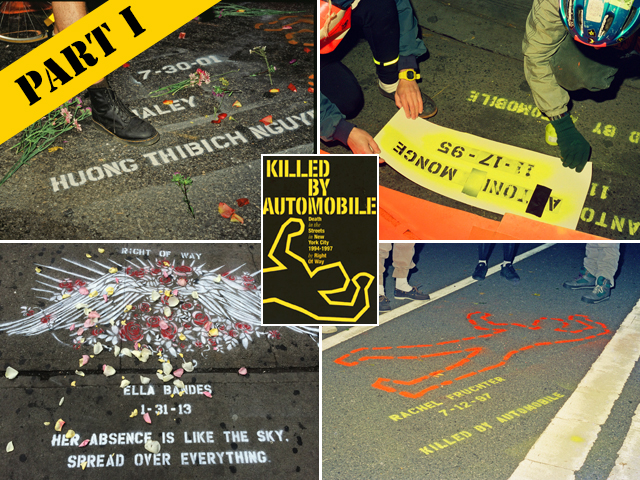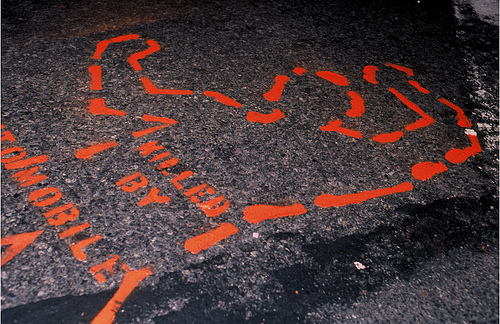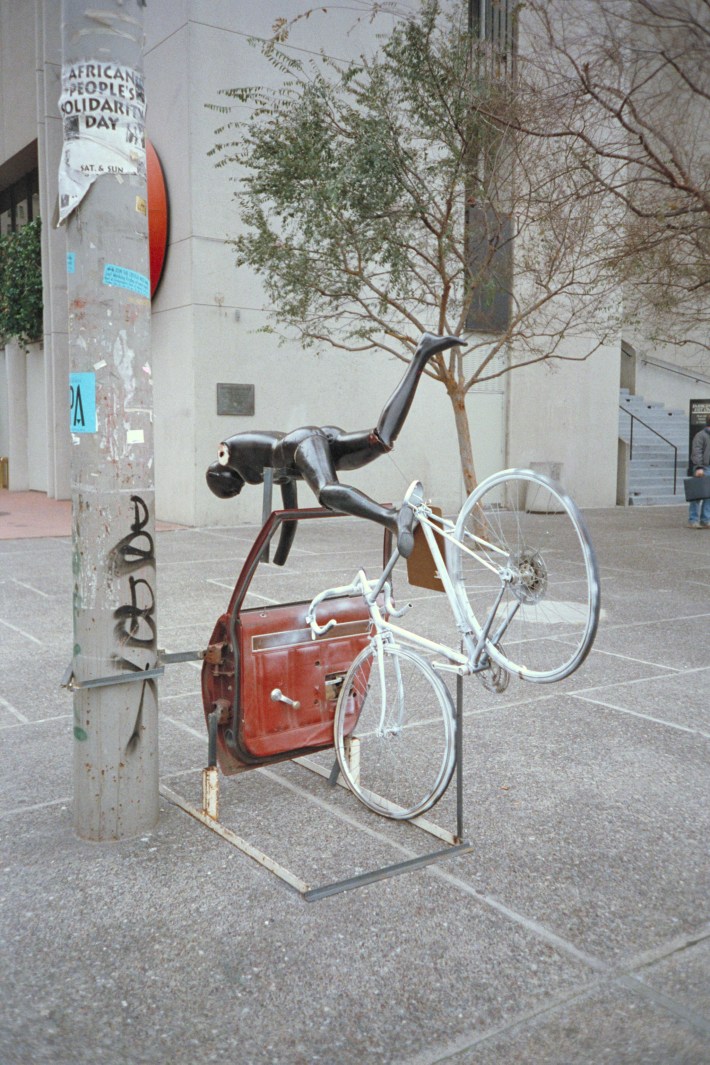The History of a Movement, Part I: Hazmat Suits and Street Memorials
12:01 AM EST on December 6, 2021

It’s Part 1, people!
Today, as we confront the bloodiest year in Mayor de Blasio's Vision Zero, Streetsblog begins a seven-part series focusing on a key strand in the movement for livable safe streets, written by a central figure in that movement, Charles Komanoff. A former head of Transportation Alternatives, Komanoff 25 years ago launched a highly effective public awareness campaign calling out the daily carnage on New York City streets. Under the name "Right Of Way," his group brought the brutal reality of pedestrian and cyclist deaths to the public eye in the form of high-visibility street actions (including one arrest). The curtain rises in December 1996. Watch for subsequent chapters in the coming days.

On a balmy, fog-shrouded Friday evening in December 1996, a half-dozen bicycle riders converged on a Midtown Manhattan curbside. Three wore hazmat suits, another towed a bicycle trailer with a folded six-foot oil-board stencil, others bore spray paint cans in their panniers.
Their mission: to memorialize Erica Morena, a 3-year-old who one afternoon was walking with her mother past the Public Library when a limo driver racing to beat the light at Fifth Avenue careened onto the sidewalk, killing her.

The white suits and plastic visors were a theatrical flourish evoking an earlier guerrilla art action in San Francisco. Dressed in uniforms monogrammed as the Dept. of Public Art, several cycling activists hoisted a sculpture of a cyclist being catapulted over an opened car door and bolted it into the ground at a downtown plaza. (Video of the installation later made its way into the samizdat documentary We Are Traffic that carried word about San Francisco’s “critical mass” bike rides around the world.)
For the New York crew, the suits afforded a dash of gallows humor and, they hoped, a protective shield. Not only were they marking pedestrian and cyclist deaths that evening, they were doing so illegally: spray-painting a splayed body outline, along with the deceased’s name, date of death and the words KILLED BY AUTOMOBILE, onto the road or sidewalk where they had been run over. In Rudy Giuliani’s Big Apple, that could mean a night in jail.
That evening, however, and on dozens of excursions to come in 1997 and 1998, the NYPD were elsewhere. It probably helped that no reporters were on hand. The group had opted for an under-the-radar approach, as both a precaution and a token of respect for those they were memorializing.

Moving furtively and efficiently, they needed just a few minutes to lean their bikes, pick out a smooth bit of pavement, sweep it clean, unfold the stencil image (dubbed “flatso,” in the same vein of dark humor), apply the paint, do likewise with the pre-cut name, date, and killed by automobile lettering, shoot photos, pack up, and hightail it to the next location.
Three stencils that night, six on the next outing, in January, another eight or so in February and subsequent months. At first just in Manhattan, but later extending to Brooklyn, Queens and the Bronx. Victim names and locations were culled from newspaper reports and grouped geographically, to keep travel times to a minimum. The memorial subjects ranged in age from another toddler, 19-month-old Constance Dupuy, who, like Erica, was killed by a driver on a sidewalk, this one backing his vehicle into a parking space on Broadway just north of West 96th Street, to seniors and folks in between.
Those memorialized had mostly been killed afoot, with a smattering of people riding bikes. That was intentional. Not only did pedestrian deaths, which then numbered around 240 a year, vastly outnumber the 15 or so annual cyclist fatalities, the group wanted to rally New Yorkers to a larger cause than bikes. We sought nothing less than to overthrow automotive domination of the city’s streets. Calling attention to the ongoing slaughter of pedestrians seemed like a good start.
We were ardent cyclists and veteran activists. The hazmat guys, if memory serves, were Peter Meitzler, bicoastal volunteer at both Transportation Alternatives and the San Francisco Bicycle Coalition; up-and-coming eco-activist Carter Craft, who would later christen our outfit Right Of Way; and Bill DiPaola, founder of the direct-action ecology group Time’s Up!
Also in the crew was my friend and cycling buddy Harris Silver, who brought two key ingredients to our organizing meeting that fall: insistence that memorializing pedestrian victims of car violence could be a more effective tactic for advancing safe cycling than conventional, infrastructure-focused advocacy — an idea proposed by his girlfriend (now wife) Sharoz Makarechi; and a sketch by an ad-industry pal that became the flatso body outline we would stencil on Dec. 13 and for years to come.
I was there, too. During the 1987 midtown bike ban uprising, I was thunderstruck when I came across NYPD data showing that car and truck drivers were killing 300 pedestrians a year in the five boroughs. A slaughter hidden in plain sight. And validation of my hatred of cars in New York.

At first, this registered mostly as an abstraction, a statistical rebuke to commonplace blame-the-cyclist for street carnage. But in 1989, as editor of Transportation Alernatives' City Cyclist ’zine, the numbers took on flesh and bone when I commissioned a story by an Associated Press journalist that dug into the deaths of three Manhattan bicycle-riders in a single week. So, too, a few years later when expert cyclist and Trans Alt volunteer Ken Morris was run over by a bus driver on a rainy night after wiping out on a slick metal road plate, according to police.
But nothing prepared me for the death in October, 1994 of pediatric AIDS researcher Jie Zhang, who was nine months pregnant when a van driver plowed into her on a street corner outside New York Hospital, where she worked. In a horrific miracle, Dr. Zhang’s colleagues delivered her baby boy, Samuel Chen, while she lay in a coma, dying.
Samuel entered the world less than a week after my own first-born, Daniel. It was Daniel’s bicycle trailer that I would pull to East 40th Street two years later on the inaugural street memorial ride. With Erica Morena’s stencil still glistening in the humid night the group cycled to York and 69th to make our second memorial, for Samuel’s mother.
On Wednesday, the series continues with Part II, which details how the movement to draw attention to road violence began to gain traction.
Charles Komanoff is a national expert on congestion pricing and traffic modeling, and is the former head of Transportation Alternatives. He is a longtime Streetsblog contributor. Reach him at komanoff@gmail.com.
Read More:
Stay in touch
Sign up for our free newsletter
More from Streetsblog New York City
Adams Backs Lower Speed Limits, Calls Crashes ‘Accidents’
The mayor wants New York City drivers to "slow down," but it's not clear yet how many streets will get lower speed limits.
Wednesday’s Headlines: Trump Posts About Congestion Pricing Edition
Donald Trump comments on congestion pricing — no surprise, he's against it. Plus more news.
DOT Aims to Build First Ave. Tunnel Bike Lane Before September’s UN General Assembly
DOT hopes to have the concrete-protect tunnel bike lane installed this summer, but its exact plans are still in development.
Waste Reforms Could Require Data on Crashes, Dangerous Driving
The proposal affects at least one trucking company with a deadly driving record.
When it Comes to Federal Infrastructure Grants, Size Does Matter
Cities and municipalities with larger budgets and staff are more likely to win competitive federal infrastructure grants, the Urban Institute has found.




